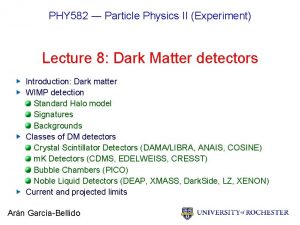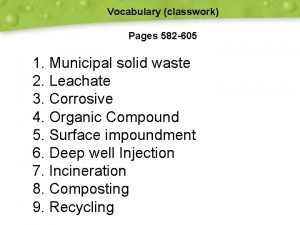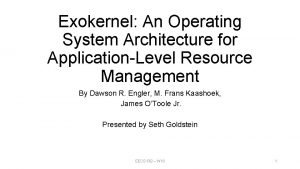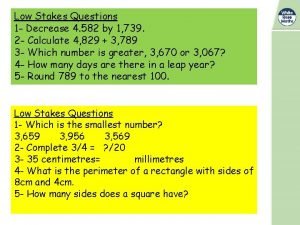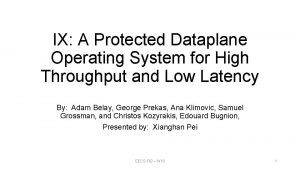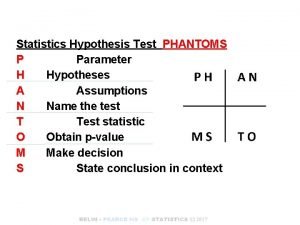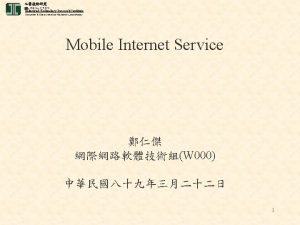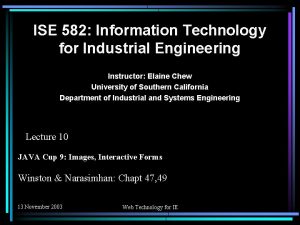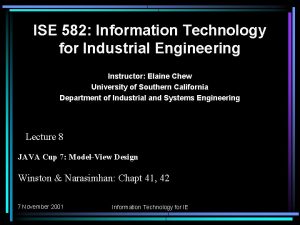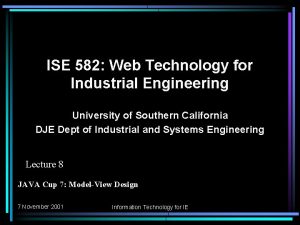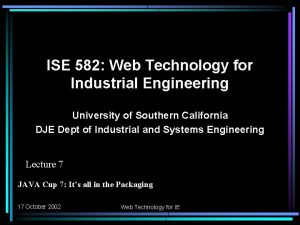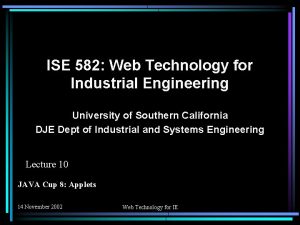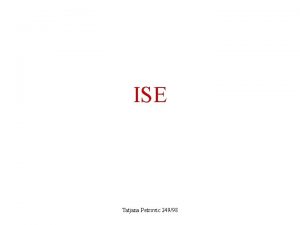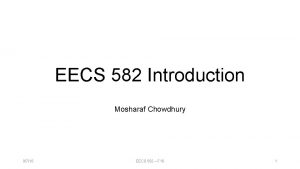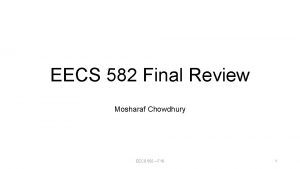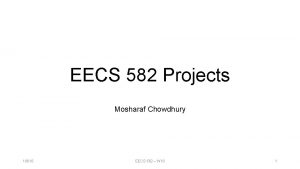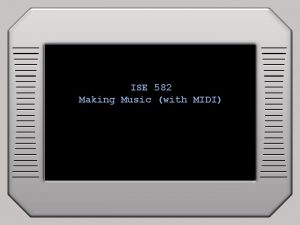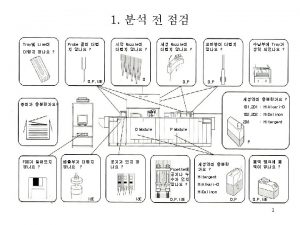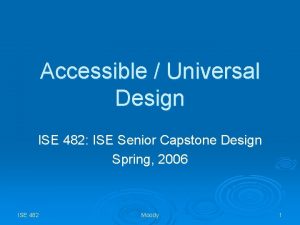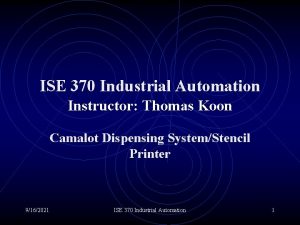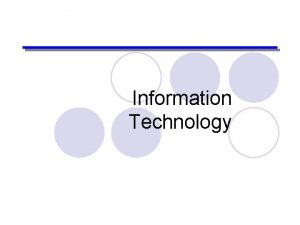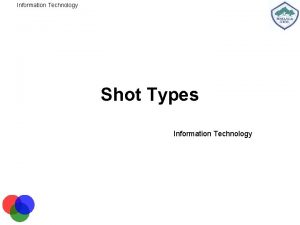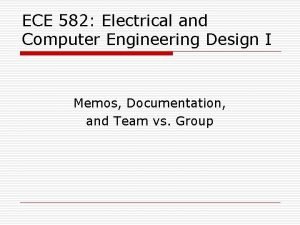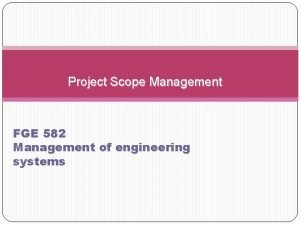ISE 582 Information Technology for Industrial Engineering Instructor














![Creating Arrays • Creating an array – <elt_type> <array_name> [] = new <elt_type> [ Creating Arrays • Creating an array – <elt_type> <array_name> [] = new <elt_type> [](https://slidetodoc.com/presentation_image/4969a879462d9b7ad1346eef14bb6f81/image-15.jpg)
![Instance Array Elements • Field-selection operator still works – movies[3]. script = 6 • Instance Array Elements • Field-selection operator still works – movies[3]. script = 6 •](https://slidetodoc.com/presentation_image/4969a879462d9b7ad1346eef14bb6f81/image-16.jpg)





![Example public class Command { public static void main(String argv[]) { Movie m = Example public class Command { public static void main(String argv[]) { Movie m =](https://slidetodoc.com/presentation_image/4969a879462d9b7ad1346eef14bb6f81/image-22.jpg)














- Slides: 36

ISE 582: Information Technology for Industrial Engineering Instructor: Elaine Chew University of Southern California Department of Industrial and Systems Engineering Lecture 6 JAVA Cup Five: Data Structures Winston & Narasimhan: Chapt 27 -31, 33 2 October 2003 Web Technology for IE

JAVA Cup 5 • File Access – Input file streams – Output file streams • Arrays and Vectors – How to create and access arrays – Expandable vectors • Characters and Strings 2 October 2003 Web Technology for IE 2

File Input Streams • • • Reading files one-byte-at-a-time Taking bigger bites Java’s input-output package Traditional string handling Updating to tokens: number / words 2 October 2003 Web Technology for IE 3

File input streams • A stream is a sequence of values. • To read bytes from a file: – File. Input. Stream stream = new File. Input. Stream(“input. data”) – File. Input. Stream stream = new File. Input. Stream(“~username/public_html/ise 582/input. data”); • When you are done, it is good to: – stream. close() • Reads ONE BYTE AT A TIME… 2 October 2003 Web Technology for IE 4

To take bigger bites than bytes • To read characters from your file: – Input. Stream. Reader reader = new Input. Stream. Reader(stream); • To read lines from your file: – Buffered. Reader buffer = new Buffered. Reader(reader); – buffer. read. Line() stream 2 October 2003 reader Web Technology for IE buffer 5

Input-output package • Notify JAVA that you want to work with input or output streams: – import java. io. File. Input. Stream – import java. io. * • In the event of error – use try-catch statements – throw an exception, throws IOException 2 October 2003 Web Technology for IE 6

Traditional Approach Example import java. io. *; public class Demonstrate { public static void main(String argv[]) throws IOException { File. Input. Stream stream = new File. Input. Stream(“input. data”); Input. Stream. Reader reader = new Input. Stream. Reader(stream); Buffered. Reader buffer = new Buffered. Reader(reader); String line; while ((line=buffer. read. Line())!=null && !line. equals(“”)) { System. out. println(“Line read: “ + line); } stream. close(); return; }} 2 October 2003 Web Technology for IE 7

String Methods • line. trim() – removes white space • line. index. Of(“ “) – index of first occurrence, starts from 0 • line. substring(2) – returns rest of line after index 2 • line. substring(0, 1) • Integer. parse. Int(“ 4”) – converts string to integer 2 October 2003 Web Technology for IE 8

Example Continued line = line. trim(); int next. Space = line. index. Of(" "); int x = Integer. parse. Int(line. substring(0, next. Space)); line = line. substring(next. Space). trim(); next. Space=line. index. Of(" "); int y = Integer. parse. Int(line. substring(0, next. Space)); line = line. substring(next. Space). trim(); int z = Integer. parse. Int(line); System. out. println("Numbers read: " + x + ", " + y + ", " + z); 2 October 2003 Web Technology for IE 9

The Token Approach • The stream tokenizer: – Stream. Tokenizer tokens = new Stream. Tokenizer(reader); – Do away with the Buffered. Reader – Divides character sequences into tokens, delimited by white space • Token Methods: – – tokens. next. Token() assigns value to nval, tokens. nval always a double, if need recasting: (int) tokens. nval end of token string indicated by TT_EOF: tokens. TT_EOF 2 October 2003 Web Technology for IE 10

Token Example import java. io. *; public class Demonstrate { public static void main (String argv[]) throws IOException { File. Input. Stream stream = new File. Input. Stream("input. data"); Input. Stream. Reader reader = new Input. Stream. Reader(stream); Stream. Tokenizer tokens = new Stream. Tokenizer(reader); while (tokens. next. Token()!= tokens. TT_EOF) { int x = (int) tokens. nval; tokens. next. Token(); int y = (int) tokens. nval; tokens. next. Token(); int z = (int) tokens. nval; Movie m = new Movie(x, y, z); System. out. println("Rating: " + m. rating()); } stream. close(); }} 2 October 2003 Web Technology for IE 11

Words vs. Numbers • If the token is a number – next. Token returns a TT_NUMBER instance – the number is assigned to nval • If the token is a word – next. Token returns a TT_WORD instance – the number is assigned to sval 2 October 2003 Web Technology for IE 12

Word / Number Example int next=0; while ((next=tokens. next. Token())!= tokens. TT_EOF) { switch (next) { case tokens. TT_WORD: break; case tokens. TT_NUMBER: int x = (int) tokens. nval; tokens. next. Token(); int y = (int) tokens. nval; tokens. next. Token(); int z = (int) tokens. nval; Movie m = new Movie(x, y, z); System. out. println("Rating: " + m. rating()); break; } } 2 October 2003 Web Technology for IE 13

Arrays and Vectors • • Creating / assigning values to arrays Passing arrays to methods Command-line arguments Creating vectors Vector methods Vectors as targets Using vector iterators 2 October 2003 Web Technology for IE 14
![Creating Arrays Creating an array elttype arrayname new elttype Creating Arrays • Creating an array – <elt_type> <array_name> [] = new <elt_type> [](https://slidetodoc.com/presentation_image/4969a879462d9b7ad1346eef14bb6f81/image-15.jpg)
Creating Arrays • Creating an array – <elt_type> <array_name> [] = new <elt_type> [ <size> ]; – int durations [] = new int [4]; • What you can do with an array – call / assign an elt: <array_name> [<index>] – find its length: <array_name>. length • Arrays of class instances – <Class> <array_name> [] = new <Class> [ <size> ]; – Movie movies [] = new Movie [4]; 2 October 2003 Web Technology for IE 15
![Instance Array Elements Fieldselection operator still works movies3 script 6 Instance Array Elements • Field-selection operator still works – movies[3]. script = 6 •](https://slidetodoc.com/presentation_image/4969a879462d9b7ad1346eef14bb6f81/image-16.jpg)
Instance Array Elements • Field-selection operator still works – movies[3]. script = 6 • Checking to see if element is assigned – movies[2] == null • Using instance as target for method – movies[1]. rating() 2 October 2003 Web Technology for IE 16

Mixing Creation and Elt Insertion public class Demonstrate { public static void main (String argv[]) { Movie movies[] = { new Movie(5, 6, 3), new Movie(8, 7, 7), new Movie(7, 2, 2), new Movie(7, 5, 5)}; int sum = 0; for (int counter=0; counter < movies. length; ++counter) { sum += movies[counter]. rating(); } System. out. print("The average rating of the " + movies. length); System. out. println(" movies is " + sum / movies. length); }} 2 October 2003 Web Technology for IE 17

Arrays and Memory • Arrays are reference type variables • Integer arrays contain a length variable and 4 bytes of memory per instance • Class instance arrays contain a length variable and several bytes for the address of each instance 2 October 2003 Web Technology for IE 18

Higher Dimension Arrays • You can easily define arrays of higher dimension – double 2 DArray [] [] = new double[2][100]; 2 October 2003 Web Technology for IE 19

Passing an Array to a Method • To designate that a parameter is array – public static Movie[] read. Data(Movie movies []) throws IOExc. . – public static Movie[] read. Data(Movie[] movies) throws IOExc. . • E. g. : put file-reads into Auxiliary Class • Some ways to define read. Data: – Create array, pass array address to method, return address – Create array, pass array address to method, return nothing – Create array variable, pass filename to method, return array 2 October 2003 Web Technology for IE 20

Command-Line Arguments • The main methods has one parameter – an array of Strings, argv[] – argv. length is # command-line arguments 2 October 2003 Web Technology for IE 21
![Example public class Command public static void mainString argv Movie m Example public class Command { public static void main(String argv[]) { Movie m =](https://slidetodoc.com/presentation_image/4969a879462d9b7ad1346eef14bb6f81/image-22.jpg)
Example public class Command { public static void main(String argv[]) { Movie m = new Movie(Integer. parse. Int(argv[0]), Integer. parse. Int(argv[1]), Integer. parse. Int(argv[2])); System. out. println("The rating is " + m. rating()); } } 2 October 2003 Web Technology for IE 22

Vectors • Vectors vs. Arrays – variable in length – insertions can occur at any point – elements can only be class instances • Provided by Java’s utility package – import java. util. * – Vector v = new Vector(); 2 October 2003 Web Technology for IE 23

Vector Methods • Insertions and deletions – – v. add. Element(m) … adds to back end of vector v. insert. Element. At(m, 0) … adds to front of vector v. remove. Element. At(0) … removes first element v. set. Element. At(m, 4) … replaces element • Access to elements – v. first. Element() – v. last. Element() – v. element. At(2) 2 October 2003 • Size of Vector – v. size() Web Technology for IE 24

A Little Quiz • Which methods do you need to represent FIFO queues? • Which methods do you need to represent LIFO queues (stacks)? 2 October 2003 Web Technology for IE 25

Vectors as Targets • All vector elements are instances of the Object class • All vector methods work with instances of the Object class • You can work with an element of the vector class by casting the element: – ( (Movie) (v. first. Element()) ). rating() 2 October 2003 Web Technology for IE 26

Example import java. io. *; import java. util. *; public class Auxiliaries 2 { public static Vector read. Data(String file. Name) throws IOException { File. Input. Stream stream = new File. Input. Stream(file. Name); Input. Stream. Reader reader = new Input. Stream. Reader(stream); Stream. Tokenizer tokens = new Stream. Tokenizer(reader); Vector v = new Vector(); while (tokens. next. Token() != tokens. TT_EOF) { int x = (int) tokens. nval; tokens. next. Token(); int y = (int) tokens. nval; tokens. next. Token(); int z = (int) tokens. nval; v. add. Element(new Movie(x, y, z)); } stream. close(); return v; }} 2 October 2003 Web Technology for IE 27

Iterators • An iterator maintains a pointer to a place on the parent vector • To create an iterator – Iterator i = v. iterator() • Some Iterator methods – i. next() … returns element, advances pointer – i. has. Next() 2 October 2003 Web Technology for IE 28

Example import java. io. *; import java. util. *; public class Demonstrate { public static void main(String argv[]) throws IOException { Vector main. Vector = Auxiliaries 2. read. Data("input. data"); int size = main. Vector. size(); for ( Iterator i = main. Vector. iterator(); i. has. Next(); ) { System. out. println(( (Movie) i. next() ). rating()); } } } 2 October 2003 Web Technology for IE 29

Working with Char & Strings • What you can do with Strings • Specifying delimiters in File-reads 2 October 2003 Web Technology for IE 30

The String s • • s. length() … compare this to arrays + concatenates two strings s. char. At(0) extracts first character s. char. At(0)==‘M’ … note single quotes switch(s) … use in switch statements char c = s. char. At(0); default character is ‘u 000’ 2 October 2003 Web Technology for IE 31

Example (excerpt) while (tokens. next. Token() != tokens. TT_EOF) { String code. String = tokens. sval; tokens. next. Token(); int x = (int) tokens. nval; tokens. next. Token(); int y = (int) tokens. nval; tokens. next. Token(); int z = (int) tokens. nval; switch (code. String. char. At(0)) { case 'M': v. add. Element(new Movie(x, y, z)); break; case 'S': v. add. Element(new Symphony(x, y, z)); break; } } 2 October 2003 Web Technology for IE 32

Specifying Delimiters • To advise the tokens tokenizer to use double quotation marks to delimit strings: – tokens. quote. Char((int) ‘”’) • To tell the tokenizer to recognize carriage returns: – tokens. eol. Is. Significant(true); 2 October 2003 Web Technology for IE 33

Example (excerpt) tokens. quote. Char((int) '"'); tokens. eol. Is. Significant(true); Vector v = new Vector(); while (tokens. next. Token() != tokens. TT_EOF) { String name. String = tokens. sval; tokens. next. Token(); int x = (int) tokens. nval; tokens. next. Token(); int y = (int) tokens. nval; tokens. next. Token(); int z = (int) tokens. nval; Movie m = new Movie(x, y, z); m. title = name. String; if (tokens. next. Token() == tokens. TT_EOL) {} else { m. poster = tokens. sval; tokens. next. Token(); } v. add. Element(m); } 2 October 2003 Web Technology for IE 34

Working with O/p File Streams • To connect to output file – File. Output. Stream stream = new File. Output. Stream(“output. data”); • To write more than 1 -byte-at-a-time – Print. Writer writer = new Print. Writer(stream); • It’s good to flush out buffered characters – writer. flush() • Close the file – stream. close() 2 October 2003 Web Technology for IE 35

Example (part) import java. io. *; import java. util. *; public class Demonstrate { public static void main(String argv[]) throws IOException { File. Output. Stream stream = new File. Output. Stream("output. data"); Print. Writer writer = new Print. Writer(stream); Vector main. Vector = Auxiliaries 4. read. Data("input 3. data"); int size = main. Vector. size(); for (Iterator i = main. Vector. iterator(); i. has. Next(); ) { Movie m = (Movie) i. next(); m. write. To. File(writer); writer. println(m. rating()); } writer. flush(); stream. close(); System. out. println("File written"); }} 2 October 2003 Web Technology for IE 36
 Experiment 582
Experiment 582 Recycling of solid waste
Recycling of solid waste Eecs 582 umich
Eecs 582 umich Eecs 582
Eecs 582 Eecs 370 curve
Eecs 370 curve Find the percentage decrease from 490 to 343
Find the percentage decrease from 490 to 343 Eecs 582
Eecs 582 Phantoms statistics
Phantoms statistics Industrial technology design
Industrial technology design Industrial technology research institute
Industrial technology research institute Participante pasivo
Participante pasivo Basic instructor course texas
Basic instructor course texas Basic instructor course texas
Basic instructor course texas Basic instructor course tcole
Basic instructor course tcole Pepperball hotshot
Pepperball hotshot Subject verb agreement exercise
Subject verb agreement exercise Instructor vs teacher
Instructor vs teacher Cisco certified instructor
Cisco certified instructor Mptc firearms instructor manual
Mptc firearms instructor manual Basic instructor course #1014
Basic instructor course #1014 Basic instructor course texas
Basic instructor course texas Virtual art instructor
Virtual art instructor Nfpa 1403
Nfpa 1403 Human factors instructor
Human factors instructor Instructor operating station
Instructor operating station Catia instructor
Catia instructor Instructor
Instructor Instructor responsibilities and professionalism
Instructor responsibilities and professionalism Tcole 1014 basic instructor course
Tcole 1014 basic instructor course Jrotc marksmanship instructor course online
Jrotc marksmanship instructor course online How to become an nrp instructor mentor
How to become an nrp instructor mentor Utp cable
Utp cable Cbrf registry wisconsin
Cbrf registry wisconsin Nra certified instructor logo
Nra certified instructor logo Naismith was an instructor of
Naismith was an instructor of Please clean your own room
Please clean your own room Tcole advanced instructor course
Tcole advanced instructor course
